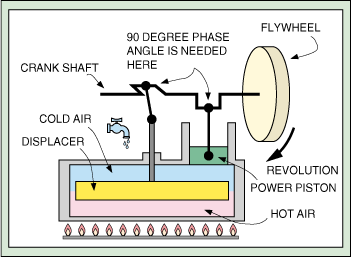

Stirling engines have two pistons that create a 90 degree phase angle and two different temperature spaces. The working gas in the engine is perfectly sealed, and doesn't go in and out to the atmosphere.
Stirling engines can be classified as two pistons type Stirling engines and displacer type Stirling engines. The two pistons type Stirling engine consists of two power pistons. The displacer type Stirling engine consists of one power piston and a displacer piston.
 The two pistons type Stirling engine is shown in this figure. A space above a hot piston is always heated by a heat source. A space above a cold piston is cooled always.
The two pistons type Stirling engine is shown in this figure. A space above a hot piston is always heated by a heat source. A space above a cold piston is cooled always. Please click next buttons and you will see a operation principle of the two piston type Stirling engine.
Animation
(Netscape2.0 is demanded.)
 The displacer type Stirling engine is shown in this figure. A space above a displacer piston is always heated by a heat source. A space below the displacer piston is cooled always. The displacer piston displaces hot air and cold air.
The displacer type Stirling engine is shown in this figure. A space above a displacer piston is always heated by a heat source. A space below the displacer piston is cooled always. The displacer piston displaces hot air and cold air.Please click next buttons and you will see a operation principle of the displacer type Stirling engine.
Animation
(Netscape2.0 is demanded.)